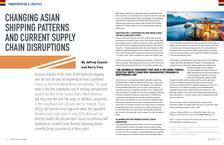
Changing Asian shipping patterns and current supply chain disruptions in the US
Most goods imported from Asia today flow through West Coast ports, and then are moved eastwards, overland, by intermodal and truck. The expanded canal, larger ships, Eastern port dredging and other port improvements will reduce the overland flow, allowing more goods from Asia to enter through Gulf and East Coast ports. These changes will provide an economic boost to these areas.
How much will container volume grow along the Gulf & East Coast?
A recent Journal of Commerce article predicts that when the new Panama locks open in early 2016, there will be double digit percentage growth in container shipments via the canal the first year, followed by an ongoing five percent year over year growth thereafter. If these projected growth rates are realized, by 2020 additional containers handled by Gulf and East Coast ports as a result of the Panama Canal expansion would grow by more than 1.3 million a year. Other projections foresee even higher traffic. There are two primary considerations to balance: transit times and cost savings. The additional transit time to ship from Asia to the East Coast through the Panama Canal, adds anywhere from two to ten days in comparison to West Coast ports, depending on the destination. However, there are also delays in the current method of shipping.
"The number of companies that have a top down, formal, effective supply chain risk management program is surprisingly low." |
The ports of Los Angeles and Long Beach, the largest West Coast ports, are at or near capacity and are experiencing serious congestion and labor issues, adding cycle time and inventory carrying costs, as well as negatively affecting inventory availability and delivery downstream. Furthermore, congestion in the high volume Chicago rail yards frequently adds a day or two of delay for every container shipped through the city. The cost difference to ship via the Panama Canal is the major driver for change since each new large vessel can allocate its operating costs across three times as many containers as current ships, therefore significantly reducing the landed cost per container. Rail and road costs to support the East will also be lower.
Planning for the present supply chain disruption
The landscape painted above sounds very promising. However, until this becomes reality, the supply chain disruptions being experienced today in Long Beach and L.A. will most likely continue in some form. This congestion is being magnified by the backlog of ships waiting to be unloaded and, even when purged, delays occur. Presently, companies that have not planned for this type of supply chain disruption are faced with increased cycle times, lack of inventory and increased shipping costs. It is estimated that it will take months to free up the pipeline. Downstream, customer service is and will continue to be negatively affected with respect to fill rate and delivery times.
"Now is the time to plan for inevitable future supply chain disruptions. Make no mistake, they will occur in some form and a well-structured contingency plan is vital." |
The number of companies that have a top down, formal, effective Supply Chain Risk Management Program is surprisingly low. Companies that analyze their entire supply chain network and develop contingency plans based on itemized, potential disruption events are better prepared for the present disruptions.
A flexible network that allows for quick response to changing conditions would be able to handle sudden changes like the current slowdown through an established operational, cost and service plan. Analysis and understanding of potential solutions such as prior pipeline fill, out of network shipping, use of alternate ports, expedited transportation modes, lead time compression, and alternate supplier sourcing, as well as the resultant service and cost implications, is critical in today’s ever-changing world-wide business network.
Contactar



